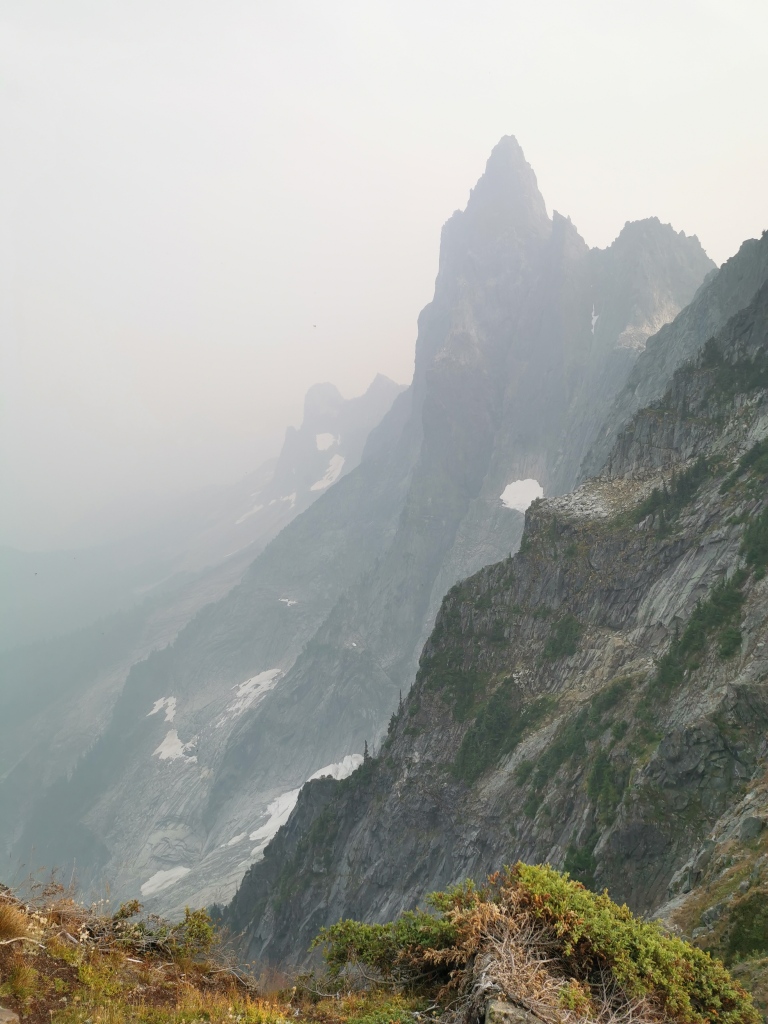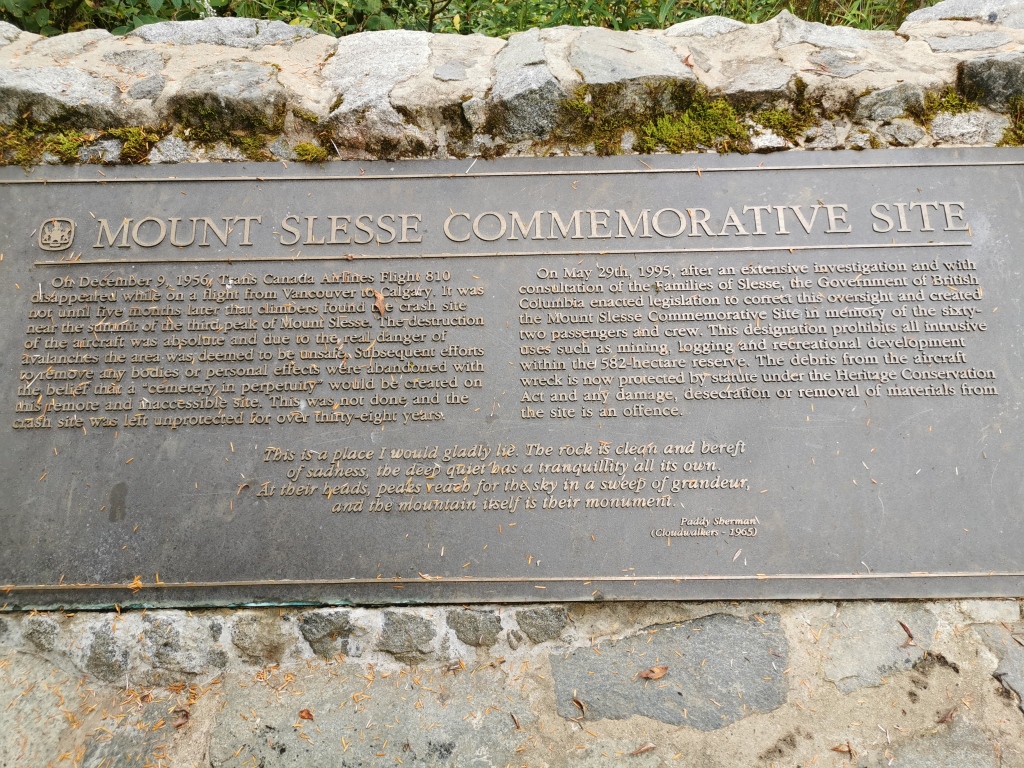Climbing Crossover Pass via the Crack of Noon Buttress in the Chilliwack River Valley in Southwest BC.
“This is a place I would gladly lie. The rock is clean and bereft of sadness, the deep quiet has a tranquility all its own. At their heads, peaks reach for the sky in a sweep of grandeur, and the mountain itself is their monument.”
Paddy Sherman (Cloudwalkers – 1965)

Smoke had settled over the Lower Mainland, a harsh reminder of the inferno burning the forests to the south. We drove sleepily through the grayness on our way up the Chilliwack River Valley. The remnants of our summer sun were all but shrouded, and there was a damp coolness lingering on the green and gold leaves. While we knew the views on our latest alpine adventure would be less than spectacular with all this smoke, we were eager to get outside and escape the monotony of pandemic life before autumn rains hit.
Our trip objective: climbing Crossover Pass, the low point of a sharp and wicked ridge line leading up to the infamous Mt Slesse in Chilliwack, BC. A Chilliwack native myself, Slesse (pronounced Sless-ee) had long been on my adventure list; its iconic profile pierced the skyline of the highway drives of my childhood. While Slesse had been my original plan, its reputation as a formidable mountaineering objective, a recent rescue off its walls, and copious smoke, made us turn our eyes to something a bit more manageable, but still within its shadow. Crossover Ridge is gained by a steep hike into the alpine, followed by a ten pitch rock climb up a newly created route named Crack of Noon Club (a very accurate name, but more on that later).

The adventure started at the turnoff to the Slesse Memorial trail, a well-marked, gravel road right after Riverside Campground on Chilliwack Lake Road. The rough road quickly becomes a slow rock-crawl for high clearance 4x4s only. At about 6.5 km, a tall wooden sign marked the Slesse trailhead. Here, we parked and put the finishing touches on our overnight packs. After some minor difficulties (I had a painful run-in with some poison ivy!), we set out on the trail.


The Slesse Memorial trail offers a unique piece of local history. In 1956, Trans Canada Airlines Flight 810 disappeared while en-route to Calgary. Months after the disappearance, the wreckage of the plane was discovered by some climbers beside Mt Slesse. It was determined that the plane had crashed into the third peak, resulting in the death of all 62 passengers and crew. Due to the harsh terrain and remoteness of this area, not all of the wreckage of this disaster was recovered, and pieces still remain in this region today. In 1995, the Government of British Colombia enacted legislation to protect this site, naming it the Mount Slesse Commemorative Site. Today, trekking the entire length of the trail will lead you past a memorial plaque, with a stunning view of the mountain itself, as well as to the base of the peak, known as Propeller Cairn. Here, the plane’s propeller and other debris stand in memory of the crash.


Our trek took us about halfway down the memorial trail, a lovely forest walk with a slight incline. About 100 m before the memorial plaque, we diverged onto the well-marked trail for Crossover Pass. Here, we followed flagging up an intensely steep slope for a couple hours. With both climbing and camping gear, this section was quite a slog!
At about 1600 m, the trail breaks into the alpine, and it was here that we found our campsite: a huge, flat rock slab, offering unobstructed views of Slesse, the ridge line, Crossover Pass, and the buttress we intended to climb. After lunch and camp setup (and maybe a quick nap…), we decided to make a summit push that day. Some other climbers in the area told us that the route only took a couple hours to ascend, so even midway through the afternoon, we figured we had time. It was well past 2pm; we decided then that Crack of Noon Club was a fitting name.


From camp to the start of the route is a 30-minute traverse through the alpine and rock fields. About 3 minutes past camp, we found running water, and filled our bottles. From here, bright flags and cairns took us over a loose debris field from a recent rock-slide. We were warned to use extreme caution here, as the stone and sand beneath our feet was loose, and as a partly collapsed mountain wall loomed over us, perhaps ready to blow any time. We moved quickly so as to not tempt fate, and made it to the base without incident.
Marked by more colourful tape, and a bolt about 15 feet above our heads, was the start of Crack of Noon Club. This ten pitch alpine climb had caught our attention as a low-stress way of sneaking in some extra alpine at the end of the season. With a first ascent only a month prior (Aug 2020), everything was clean, sharp, and well marked. For details on the climb itself, plus my review of the route, check out the description on Mountain Project.


Despite being tired after a steep hike, we made short work of the route, doubling pitches with our two half ropes. After the final anchor, a short and sandy scramble led us to the top of the ridge. The line disappeared into the smokey sky on either side of us, Slesse looming ominously in the distance, accessible by a traversing a number of sharp peaks. We’d heard the rock became bad here, crumbling and chossy; the traverse would have to wait for another day. With only a few hours of daylight left, we didn’t linger. Five 60 meter rappels brought us back down to the rock field.






The sun had lit the smokey haze a burnt orange as it lowered. We made our way slowly and carefully back over the rock-slide debris and towards camp. Each step was harder this time, and slips more likely. Fortunately, with camp close by and visible, there was little risk of serious incident. We made it back with enough remaining daylight to cook dinner and get a fire going. The night was surprisingly warm for September at 1600 meters. We curled up like cats by the fire, and dragged our sore legs to bed quite early.

The morning brought a pale blue sky directly overhead, but rims of smoke still obscured the views around us. We packed quickly, and headed down the trail. The steep climber’s trail was not much fun to descend, but fortunately it was much quicker on the way down. Including a ten minute break to see the Slesse crash memorial plaque, we made it back to the truck in about two hours.
For reference, the parking lot sits at about 700 m, the campsite, at around 1600 m, and the top of Crossover Pass at 2000 m. In a single-day push to the top of the Pass, you’ll climb about 1300 m total.

Despite the smoke, this easy climb, plus the rugged and stunning peaks at the edge of the Cascades, was the perfect end to a summer of climbing. Sore and sleepy, we concluded the trip with a stop for delicious treats at Chestnut Springs Organic Bakery in Yarrow. Mission accomplished.
Have anything left on your summer adventure bucket list? Rain is coming. Let me know in the comments below!

What an amazing journey. Awesome photos as well.
Sent from my iPhone
>
LikeLike
It was one of the coolest this year, for sure! Thanks for reading! 🙂
LikeLike
Wow! The smoke makes it look even more ominous. That Mt Slesse just goes straight up. If Chilliwack hadn’t caught my eye, I never would have guessed this to be in the Fraser Valley.
LikeLike
Yes, it does look a little out of place if you haven’t gone hiking in that area! I guess it’s the edge of the Cascades or something. Thanks for reading Caroline! 🙂
LikeLike
I guess anytime is a good time for a nap 😛
LikeLike